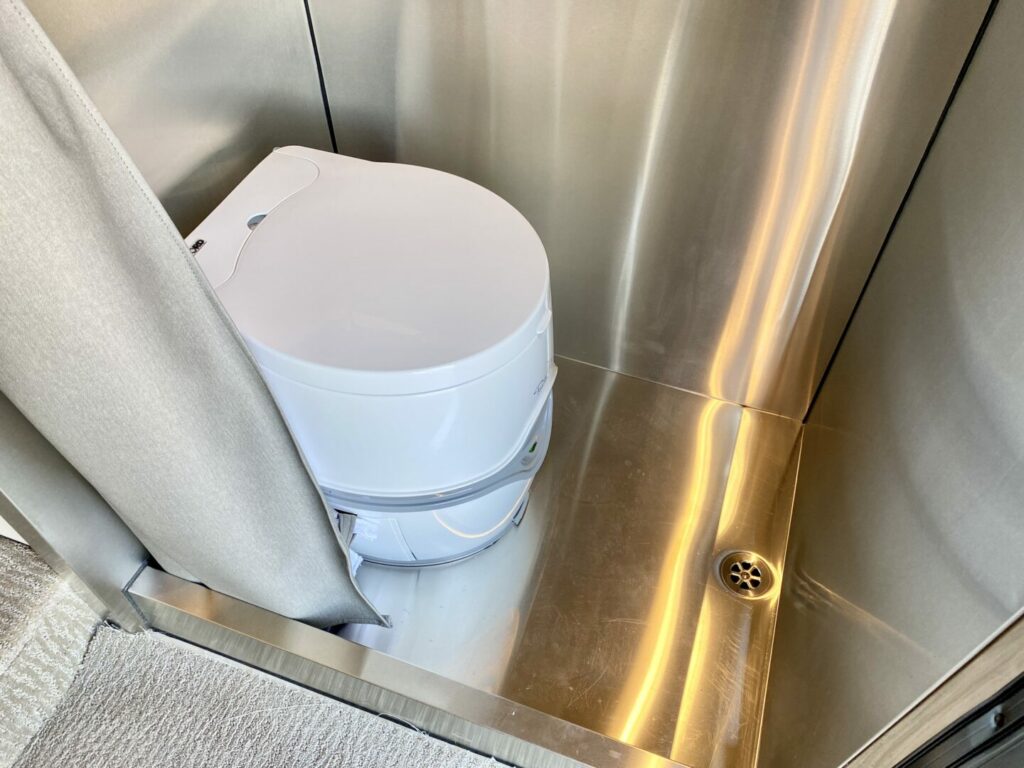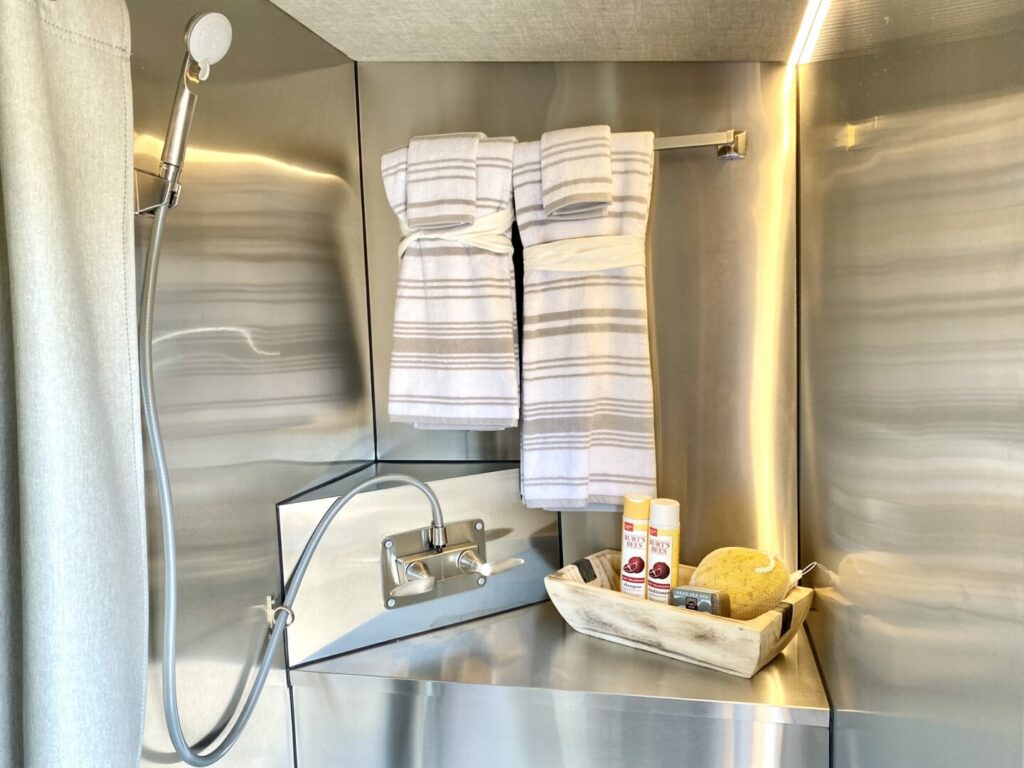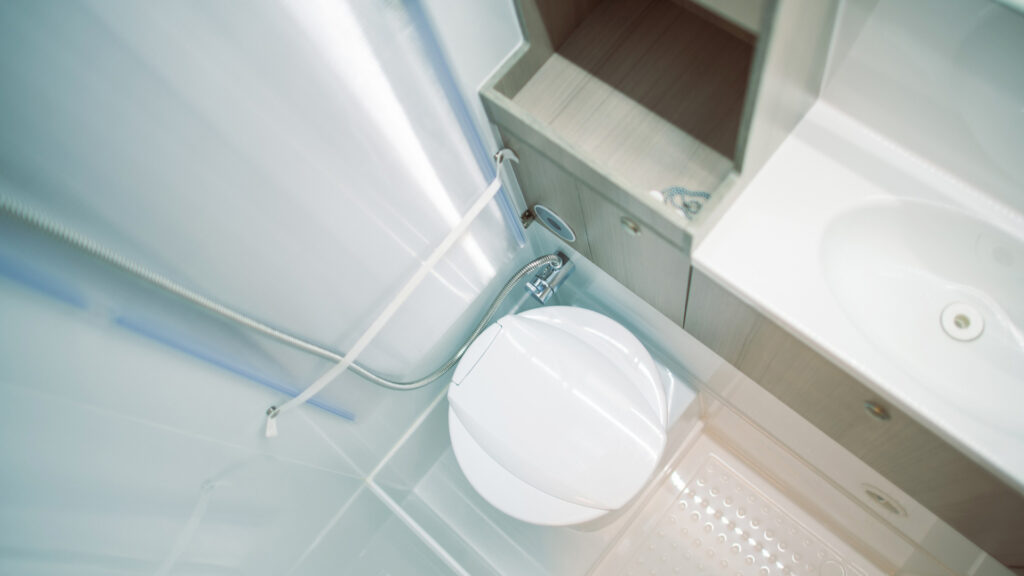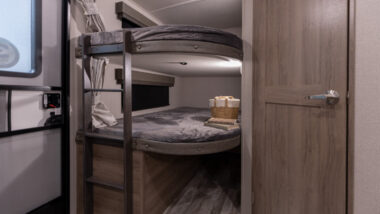Table of Contents Show
To wet bath or not to wet bath? That is the question! This topic can pose a real dilemma.
Squeezing an entire bathroom into a tiny space has its challenges. Many want to shower in the privacy of their rig but don’t want to sacrifice the square footage.
As a result, wet baths have become a popular solution. Are they worth it? Let’s take a look!
What Is a Wet Bath?
A wet bath is a tiny bathroom where the shower, toilet, and sometimes a sink share the same space. The shower will drench the toilet and sink when the occupant uses it.
Popularized by marine wet baths, RVers and Vanlifers use wet baths to save living space. They have a private room to shower indoors but have to deal with the fact that their entire bathroom gets wet.
As a result, wet baths need to be waterproof and made of mildew-resistant materials.

What Is the Difference Between a Wet Bath and a Dry Bath?
A dry bath is similar to a bathroom in your house. The shower is in a separate space, and a shower curtain or door keeps the rest of the bathroom dry. Most RVs utilize this bathroom, though they’re usually much smaller than a residential bathroom.
Dry baths are typically the preference because they require less prep and maintenance and have more storage, but they also take up more space than wet baths.
How Do You Take a Wet Bath?
Before you take a wet bath, it’s essential to remove any toiletries that you don’t want to expose to water. This includes toilet paper, towels, toothpaste, toothbrushes, and any clothes you may have in the bathroom.
You may want to prep the space by closing the toilet lid, laying down a shower mat, putting an absorbent mat on the floor outside the wet bath, and hanging a towel outside the bathroom for later.
Treat your entire bathroom as if it were a shower. It’s essential to prepare the space to get as wet as the inside of a bathtub!
How Do You Dry a Wet Bath in a Camper?
Everyone has their method of drying their wet bath, but an absorbent towel usually works fine.
Others swear by the squeegee method, where they use a handheld squeegee to get the excess water off the walls.
Another way of drying out the area is to use a ceiling vent, like the MaxxAir fan, to create airflow in and out of the wet bath. It’s crucial to have a venting system while you’re showering.
Keep in Mind: Whether you have a wet or dry bath, you’ll love these RV Bathroom Accessories!
5 Reasons to Avoid RV Wet Baths
Wet baths provide a way to shower in the privacy of your RV while saving space, but they have significant downsides as well. Let’s take a look at five reasons why you might want to think twice.
1. Everything Gets Wet
Your toilet, the floor, the sink, walls, and anything you might have accidentally left out will get wet.
This might not feel like a big deal at first, but after your 30th shower, you might get sick of having to dry off an entire room constantly. It can feel like your bathroom is continuously wet, especially if you’re a couple or a family with kids.
There’s nothing worse than using the bathroom after someone showers and sitting on a damp toilet seat! And as much as you try and keep it dry, the toilet paper is always slightly soggy.
2. They’re Small and Uncomfortable
Designers make wet baths to save space, but at what cost? When you’re showering, you’re constantly tripping over the toilet or bumping into the sink.
When using the bathroom, you’re in a small, damp space that never feels dry enough. With such a wet, claustrophobic room, sometimes it’s better to shower outside.

3. Lack of Bathroom Storage
With such a small bathroom, you can say goodbye to ample storage space. Coupled with the fact that keeping your bathroom dry is a challenge, this makes storage almost impossible.
You’ll need to find other areas in your rig to store your bathroom products, which can be challenging in a small space.
4. Drying It After Use
Constantly having to dry your bathroom after every shower gets old. This is especially true if you have kids and you have to dry the bathroom after they shower, too.
While a squeegee can work wonders, you’ll probably still need some help from towels, which will also need to dry.
Keep in Mind: If you want to check out some cool small campers, here are the 10 Best Small Campers With Bathrooms!

5. Must Keep the Moisture Under Control
Moisture can be a real problem in RVs and vans. Heating, cooking, and showering in a small space is a recipe for humidity build-up, and having a wet bath doesn’t make things any easier.
To combat the issue, you’ll need to install an excellent vent system, thoroughly dry the space after use, and consider cooking outside. With all this trouble, wouldn’t it be better to find other ways of showering?
Is a Wet Bath Worth It?
Many RVers opt for a wet bath because they believe they’ll get an indoor bathroom that doesn’t sacrifice limited living space. However, it doesn’t take long to discover the many inconveniences.
You can’t keep dry items in your bathroom. Your toilet is constantly wet, and drying your walls after use becomes painful. So, is a wet bath worth all this hassle?
While we understand why many people find them appealing, we think it would be better to expand your bathroom space or invest in an outdoor shower setup.
What do you think? Let us know in the comments below!







The only thing worse than a corner bed, is probably a wet bath, LoL! But if you’ve chosen a small vehicle for manoeverability, off-road capability or other reasons then a wet bath is a space saver, and certainly better than no shower at all. Smaller vehicles have smaller holding tanks and will likely limit the number and duration of showers. From a purchase point of view, a smaller vehicle with a wet bath will often cost more than say, a Class C motorhome with a combo or galley bathroom. Like everything else RV… it’s all about the choices and the compromises.